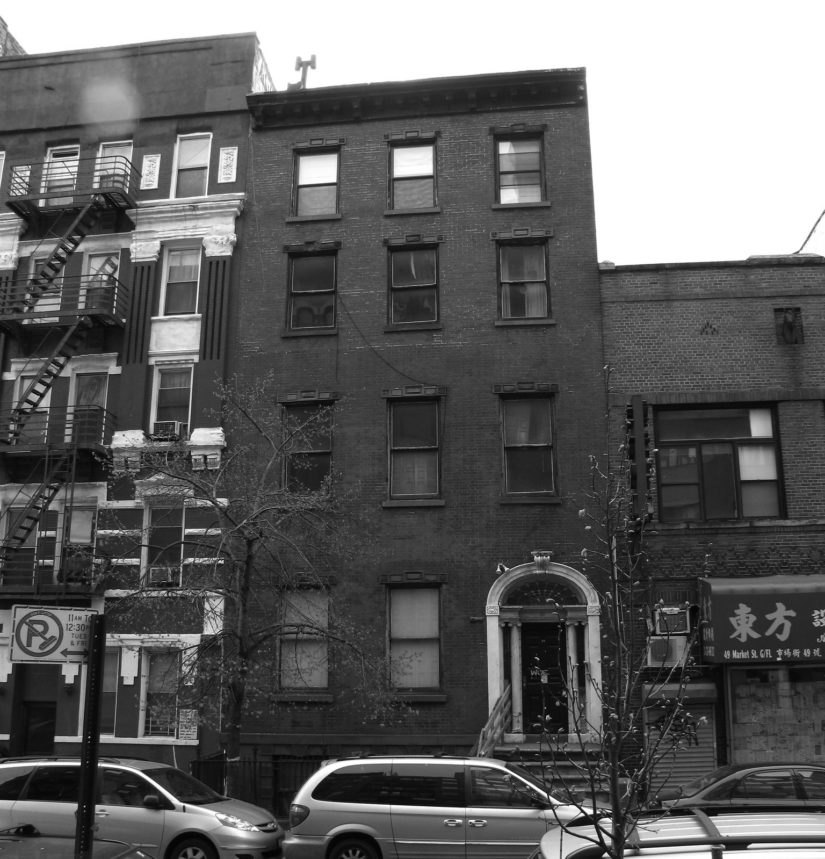
William and Rosamond Clark House
Also known as 51 Market Street House
This building is one of the last remaining examples of Federal-style architecture in New York and was among the city’s first designated individual landmarks.
The William and Rosamond Clark house is an excellent example of a late Federal style home.1 Originally a two-story, gambrel-roof house, 51 Market Street was later elevated to four floors. The stone and glass entranceway is considered the primary architectural highlight of the building.2 Other highlights include the brownstone English basement, the red brick facade, and paneled lintels.
51 Market Street is representative of the revival of construction in the Lower East Side following the War of 1812. William Clark, a local merchant and grocer, began construction of the brick-faced home in 1824. At his death at age 51 in 1836, his address was listed as 43 Market St. It is uncertain whether Clark ever lived at No. 51, having intended to rent out the two-floor building, or if the numbering changed in the mid-nineteenth century.3 Today, the Clark House’s exterior stands as a reminder of a time when the Lower East Side was the wealthy part of New York City.4
51 Market Street is currently a residential rental building. The building was designated a New York City Landmark on October 14, 1965.5 In 1977, the Clark House was added to the National Register of Historic Places.6
1865-1876: Following the end of the Civil War, the roof is raised, adding two floors to the house.
1965: The building was named a New York City Landmark on 14 October.
1977: The building was added to the National Register of Historic Places on 29 July.
On October 19, 1835, the New York City Board of Assistants passed an ordinance “for the correction of a nuisance at No. 51 Market Street.” The ordinance received mayoral approval on October 29. The “nuisance” was not clearly described in the minutes of the Proceedings of the Boards of Aldermen, and it is unknown what alteration was made. In the late 1860s or early 1870s, the original gambrel or Dutch roof was removed and an additional two stories were added to the building.8
During the Great Depression, Columbia University acquired the building and would ultimately sell it in 1945. That year, 51 Market Street had been appraised at $515,000, equal to $7.4 million in 2020.9 51 Market Street received New York City Landmark status on October 14, 1965. In 1977, the Clark House was added to the National Register of Historic Places. In 2010 the front stoop was removed and replaced with one that resembles brownstone.10 Since its construction, 51 Market Street has had its windows replaced, but the original doorway remains, having suffered both wood rot and graffiti as the result of inadequate maintenance.
- “William and Rosamond Clark House,” Historic Districts Council, 10 October 2020.
- Norval White, Elliot Willensky, Fran Leadon, “51 Market Street,” AIA Guide to New York City, 2010.
- Tom Miller, “The Wm. Clark House — No. 51 Market Street,” Daytonian in Manhattan, 20 February 2015. http://daytoninmanhattan.blogspot.com/2015/02/the-wm-clark-house-no-51-market-street.html
- David W. Dunlap, “Downtown, Federal Era Blooms in Hiding,” New York Times, 20 June 2003.
- Landmarks Preservation Commission, “Designation Report for 51 Market Street House,” Calendar No. 8 LP-0008, 14 October 1965.
- House at 51 Market Street, National Register Information System, National Register of Historic Places, accessed 21 December 2020, https://npgallery.nps.gov/NRHP/AssetDetail?assetID=a795b6eb-b3ce-44e5-94d1-ae56046d3899
- Miller, “The Wm. Clark House — No. 51 Market Street,”
- Ibid.
- Ibid.
- Ibid.